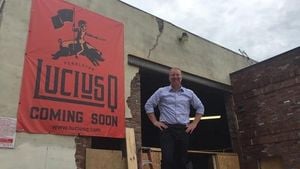Addressing home energy efficiency is becoming increasingly important as concerns about climate change and rising energy costs grow more urgent. With various measures being considered and implemented worldwide, homeowners and policymakers alike are exploring innovative solutions to improve energy efficiency and reduce carbon footprints.
One significant development is seen at Lakes College, located in Workington, Cumbria, where a new training center was recently established to address the glaring skills gap within the low-carbon heating sector. This endeavor was bolstered by £200,000 of government funding aimed at creating courses focused on technologies such as air and ground source heat pumps and solar thermal systems. Chris Nattress, the principal of Lakes College, emphasized the importance of these developments, stating, "Net Zero is a matter of great importance and the UK and Cumbria have ambitious green targets to hit to protect our planet for future generations." The Heat Pump Association noted the demand for around 33,700 qualified heat pump installers will grow as the UK shifts toward greener heating systems. Currently, only about 7,100 installers are certified, which raises concerns about the industry’s ability to meet the targets set forth by the government.
The UK government has committed to upgrading numerous homes as part of its Warm Home Plan, which is aimed at boosting energy efficiency across the country. The initiative not only encompasses low-carbon heating technologies, but it also promotes the installation of solar energy systems, battery storage solutions, and electric vehicle charging stations. Short professional courses at Lakes College will soon be available for those wishing to enter this rapidly developing field.
Across the pond, the challenges of energy efficiency are similarly pressing. Various states are implementing initiatives to promote more sustainable practices at the residential level. For example, efforts are being made to encourage homeowners to adopt advanced insulation practices, improve the efficiency of heating systems, and engage with renewable energy sources. Despite these initiatives, many homeowners struggle to see the return on investment needed to justify pursuing comprehensive energy-efficient upgrades.
One aspect of this conversation is the dual challenge posed by the complexity and cost of implementing new energy-efficient technologies. A report highlighted by The Washington Post emphasizes the need for more accessible information and financial assistance for homeowners considering energy-efficient upgrades. Various financial incentives are available, including tax credits and rebates, yet many are not aware of these options or how to apply for them. Addressing this lack of awareness could bridge the gap for homeowners eager to make greener choices.
One technology gaining traction is the development and use of energy storage solutions. For example, recent innovations have focused on creating batteries capable of storing wind and solar energy, which can then be distributed during peak consumption times. These systems allow consumers to use renewable energy even when the sun isn't shining or the wind isn't blowing, effectively balancing the energy supply and demand.
While some states are taking steps forward, others are facing resistance from the public. Proposed renewable projects, such as the Fox Meadows Wind project in Alberta, Canada, have sparked concern among local residents. This initiative, intended to produce 165 megawatts from 25 wind turbines, has drawn opposition over its potential impact on the environment and local wildlife. The Alberta Utilities Commission is currently evaluating the proposal, with many residents voicing their worries about aesthetic harm and noise pollution.
Despite these tensions, experts point to the pressing need for comprehensive solutions to combat the climate crisis. The continued push toward cleaner energy and greater efficiency throughout the home energy spectrum reflects shifting priorities among governments, businesses, and consumers alike. The transition to renewable energy sources not only aims to reduce dependence on fossil fuels but also to address global warming concerns, integrating sustainable practices within everyday life.
On the technological front, advancements are helping ease the path toward energy-efficient living. Smart home technology, for example, allows homeowners to monitor and control their energy consumption efficiently. Smart thermostats and energy-efficient appliances are part of this growing trend, enabling homes to automatically adjust energy usage based on time of day or occupancy.
Looking forward, several experts believe enhancement to energy efficiency must include proactive measures at the community level. Collaboratives between local governments, businesses, and educational institutions can create opportunities for training programs and workshops to offer residents accessible education about the benefits of energy efficiency. Municipalities can also incentivize retrofitting older buildings to meet current energy standards.
The ramifications of adopting energy-efficient practices are significant. By investing resources initially, homeowners can save substantial amounts over time through reduced utility costs and increased property value. The integration of sustainable practices not only contributes to the greater need for climate action but also creates local jobs within the green energy sector.
Providing educational resources about energy-efficient practices is particularly important for leading the charge toward more sustainable living. Awareness campaigns conducted through local channels or partnerships with organizations can help inform homeowners about potential upgrades and available assistance. From workshops to digital courses, varying methods can be employed to reach different demographics effectively.
Transitioning to energy-efficient solutions may still be complex, but the importance of such efforts to combat climate change cannot be overstated. The coordinated efforts across regions to develop greener technologies and skills underline the urgency and necessity for societal cooperation to build a more sustainable future.
Another significant hurdle remains the necessity of encouraging public interest and participation. Governments and organizations are tasked with creating engaging campaigns to motivate consumers to invest time and resources toward making their homes more energy-efficient. More than ever, community activism plays a role as residents band together to push for advancements in energy policies at local and state levels.
With the right information and resources, the path to energy efficiency can become clearer for homeowners everywhere. The initiatives at Lakes College, proactive community engagement strategies, and the push for advanced technology all highlight the varied methods being utilized to create more energy-efficient homes. By establishing stronger connections between technology, education, and local initiatives, the dream of widespread energy efficiency can slowly begin to materialize.
At the end of the day, it’s evident—while the road toward energy-efficient homes is riddled with challenges, it’s also paved with opportunities for innovation, growth, and community engagement. The collective effort required to shift toward greener practices is more achievable with consistent collaboration and dialogue among all stakeholders, from governments to homeowners.



